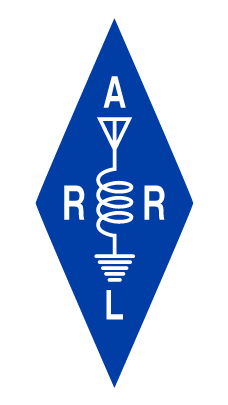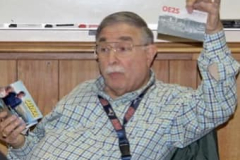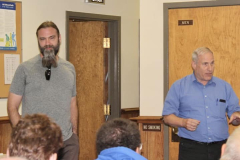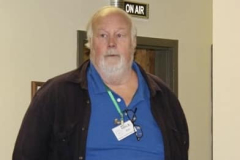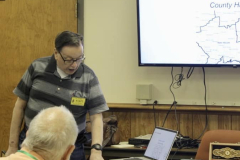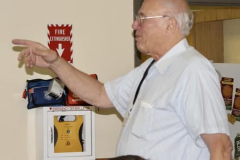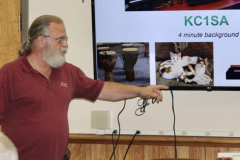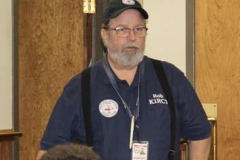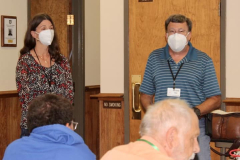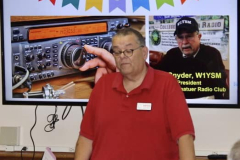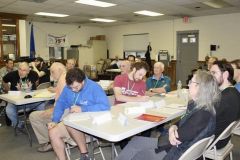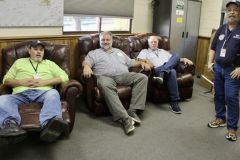Clubs
Port City Amateur Extra Study Group Meets
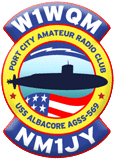 The Port City (NH) Amateur Radio Club is conducting a series of Amateur Extra study group meetings at the Piscataque Fish & Game Club in Greenland, NH. This past week, they met for approximately 1 1/2 hours. Students were asked to read several chapters from the ARRL Extra Class License Manual and come to class with one to two prepared questions for the group, “preferably a concept or idea with which you struggled during your reading.”
The Port City (NH) Amateur Radio Club is conducting a series of Amateur Extra study group meetings at the Piscataque Fish & Game Club in Greenland, NH. This past week, they met for approximately 1 1/2 hours. Students were asked to read several chapters from the ARRL Extra Class License Manual and come to class with one to two prepared questions for the group, “preferably a concept or idea with which you struggled during your reading.”
“The group is fortunate to have Dr. Mike Carter, K8CN, with us this week as their instructor,” writes Kirby Francis, KC1RWR. “Mike holds advanced degrees in Electrical Engineering and Computer Information systems, and is an Emeritus Professor of Electrical and Computer Engineering at UNH.
“For those who already hold the Extra License, if you have ever wanted to really understand the principles covered in this chapter, you’ll never get a better chance. Along the way, your attendance will encourage the students in the class to keep their resolve in face of some daunting concepts.
“We will then progress to students’ questions, and end each evening with a group trivia challenge taken directly from the exam questions on that week’s subelements! Bring your cell phone to participate in the Trivia game.”
According to KC1RWR, one of the goals of the study group is to “remove the apprehension and fear that may be preventing you from moving forward with your ham radio licensing, replacing it with a sense of community, fun, and self-confidence.”
New England QRP “Chowdercon 2023,” Portsmouth NH, September 23, 2023
Carl Achin, WA1ZCQ, writes on the NEQRP mailing list:
Tomorrow, Saturday, September 23rd is the rain-date for this year’s Chowdercon 2023. It’s happening rain or shine due to last week’s cancellations because of Hurricane Lee. The announcement bulletin already went out, yesterday, this is just a reminder with additional information.
The diehards arrive at 8AM and park in the Four Tree Island Parking Lot on Pierce Island just past the Fish Co-op.
Here’s last year’s write-up for you to go over to catch-up on the “history of Chowdercon”:
https://nediv.arrl.org/2022/09
Brown-bag whatever you’d like for snacks. Lunch at Geno’s at 12-noon and our farewell banquet at Warren’s startling at 4:55PM for the usual fantastic seafood dinner.
I’ll be there, … will YOU?
All the picnic tables on Four Tree Island are rooftop-covered so if there is light precipitation you and your rig will stay dry.
SEE YOU THERE WHEN YOU ARRIVE. COMMS ON ” 5 2 ” DIRECT (The National Simplex Frequency).
This may be our last chance to eat at Warren’s!!!
(It’s being sold and most likely it’ll be ‘no-more’ next year.
“CQAF” AND New England Chowdercon, September 16, 2023
Carl Achin, WA1ZCQ, writes on the New England QRP mailing list:
“CQAF” (QRP-Afield) is always on the third Saturday in September [September 16]. The NEQRP Sprint/Contest Committee is now headed-up by Shirley Márquez Dúlcey, KE1L <mark@buttery.org>.
I’m sure there will be an update before this coming Saturday, September 16th, 2023.
Also “Chowdercon” will be held on the same date (this coming SATURDAY) on Four Tree Island New Hampshire, so listen for ” W 1 C ” (Whiskey One “C”howdercon) on all the QRP frequencies during the standard time of CQAF.
https://www.newenglandqrp.org/
Thanks for your interest in QRP-Afield. See you down-the-log.
7 3 es 7 2 ,
Carl
http://qrz.com/db/WA1ZCQ
“Carl Achin – WA1ZCQ” <wa1zcq@amsat.org>
http://NEQRP.org
Granite State ARA Sports New Website Design
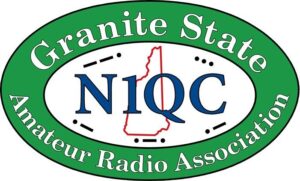
Bill Arcand, W1WRA, writes on the Granite State ARA mailing list:
Earlier today our new website has finally gone online.
There will be updates and changes as time goes on.
I really don’t want to forget any names/calls, so I wish to thank the
original web committee, as well as the folks who worked on the website.
There will be a followup email on where to send
suggestions/comments/error reports, etc being sent out soon.
Thanks and 73,
Bill
W1WRA
Meriden ARC Balloon Launch, September 2, 2023
Ed Snyder, W1YSM, writes at 12:13 PM on September 2, 2023:
Balloon is at ~36,000 feet. Telemetry available on U4B.live. W1NRG balloon app.
We have some video of the launch and lots of stills and telemetry. Signal heard all over the globe (almost all over).-Ed W1YSM
Ray Cirmo, KC1QLS, writes on the Meriden ARC mailing list:
MARC members,
We are planning a third balloon launch this Saturday September 2, 2023 between 7:30 AM – 8:00 AM weather permitting. Weather permitting this time of year will mean no precipitation, low wind speeds on the ground, and no storms over the Atlantic moving up from the South. If all of those factors are in our favor we will plan to launch from Veterans Memorial Park in Wallingford, CT, with the W1NRG callsign.
Depending on the wind direction, we may set up in one of several places within the park. If you are free and can come out and join us we would love to have you onboard for this event. Just remember if conditions are not just right we reserve the right to scrub the mission.
Tracking for this balloon launch can be done at any of the following sites:
WSPRnet.org
WSPR.rock
U4B.live (This is the site that Brian N1BRI has developed for the club balloon launches. Go to the site and on the right side of your screen you will see a button labeled W1NRG. Simply click that button and you should be good to track our progress). This is our recommended site.
We have a great deal of time and testing under our belts and we are expecting a successful launch.
Ray,
KC1QLS
Yankee Clipper Contest Club Activities at HamXposition

The Yankee Clipper Contest Club support of the Northeast HamXposition ranges from solid talks to enthralling hands-on experiences.
Check out the talks by the Club’s senior membership that appeal to new and potential contesters and those looking to take advantage of a wonderful grant program.
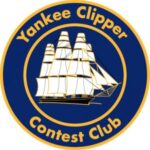 The talks begin at 2:00 on Saturday kicking off with CQ Contest Hall of Fame speaker Doug Grant, K1DG. He will tune up your on-air operating style making you the envy of your entire club during Field Day operations.
The talks begin at 2:00 on Saturday kicking off with CQ Contest Hall of Fame speaker Doug Grant, K1DG. He will tune up your on-air operating style making you the envy of your entire club during Field Day operations.
Next up is YCCC member John Vogel, N1PGA showing how he has deployed a competitive contest station without the need for tall towers. What’s the secret ingredient? Show up and find out!
Finally, YCCC member and past-President, Jim Idelson, K1IR will educate us on Amateur Radio|Digital Communications (ARDC). ARDC helps communications enthusiasts bring their dreams of innovation to life. Jim will share his recent experience as a member of the ARDC Grants Advisory Committee.
Stop by the W1A station run by Yankee Clipper Contest Club member W1VE. Gerry has secured the use of the YCCC member K1LZ Superstation located in Jonesboro, Me. Experience the thrills of massive pileups if you dare!
Finally, enjoy the superb hotel hospitality at the DX Dinner featuring YCCC member Don Greenbaum, N1DG and his talk on the “DXpeditioning with a RIB”. Don will describe the genesis of the “Rig in a Box (RIB) from the 2018 Baker Island expedition to implement on C6AGU, FO/N1DG and the recently completed VP6A Dxpedition to Ducie Island. Tickets must be purchased in advance.
Barry Hutchinson, KB1TLR, Receives Barnstable (MA) ARC Volunteer Of The Year Award
Barry Hutchinson (on left), KB1TLR, of Brewster, MA recently received the Barnstable Amateur Radio Club (BARC) Volunteer of the Year Award from BARC President Norm Cantin, WA1NLG, at the club’s August meeting. Barry has held many club leadership and ARES positions including president of both the Falmouth Amateur Radio Association (FARA) and BARC at various times. Barry also is the amateur radio coordinator for both the Falmouth Road Race and the Cape Cod Marathon, a member of the Cape ARES team and is a leader for the BARC Field Day effort. Barry also is a frequent participant at club outreach events, such as the Harwich Brooks Park and Cranberry Festivals. He has been a Technician class and merit badge instructor during the club’s JOTA activities. Barry was recently nominated for the Philip J. McGan Memorial Silver Antenna Award due to his contributions to club’s outreach efforts to the public.
Congratulations Barry!
Port City (NH) ARC Amateur Extra Study Group Begins July 19, 2023
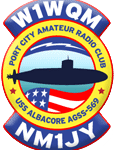 Kirby Francis, KC1RWR, writes on the Port City ARC mailing list:
Kirby Francis, KC1RWR, writes on the Port City ARC mailing list:
Amateur Extra Study Group
Where: Piscataqua Fish & Game Club
When: Wednesday, July 19th, 6:30pm (plan for about an hour and a quarter duration).
Reading Assignment: ARRL Extra Class License Manual, Pages 1-1 through 2-12
(Note that Chapter 1 is an introduction, and Chapter 2 starts exam elements E2. Read both of these, although only Chapter 2 has questions to worry about).
Class Assignment: Please come to class with 1-2 prepared questions for the group, preferably a concept or idea with which you struggled during your reading.
Each class will begin a a brief discussion of the Subelements we’ll be reviewing each week (E2A through E2E this week). For those in the club who have expertise, or feel qualified to teach certain subelements of material – please let me know, and we will give you 5-10 minutes to present. Please note that you will be scheduled during a week that this material is being covered.
We will then progress to students’ questions, and end each evening with a group trivia challenge taken directly from the exam questions on that week’s subelement! Bring your cell phone to participate in the Trivia game.
The goal of this class is to:
i) Reinforce habits of regular, applied engagement with the information you need to know for your Amateur Extra Exam
ii) Explain and apply this information using real-world examples, and the assistance of our club’s Subject Matter Experts
iii) Remove the apprehension and fear that may be preventing you from moving forward with your Ham Radio licensing, replacing it with a sense of community, fun, and self-confidence!
It’s so fun to move through this material with a group, and we look forward to seeing you all next Wednesday evening!
YCCC in NCJ
 Ken Caruso, WO1N, writes on the Yankee Clipper Contest Club mailing list:
Ken Caruso, WO1N, writes on the Yankee Clipper Contest Club mailing list:
Check out the July/August issue of [National Contest Journal]. In there you will find an article written by John, NN1SS, on how to keep Murphy out of your contest operations and an NCJ Profile on John, K1ESE, written by John himself.
Congrats guys!
73,
Ken, WO1N
